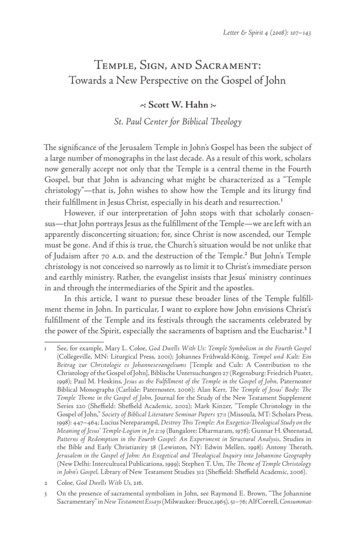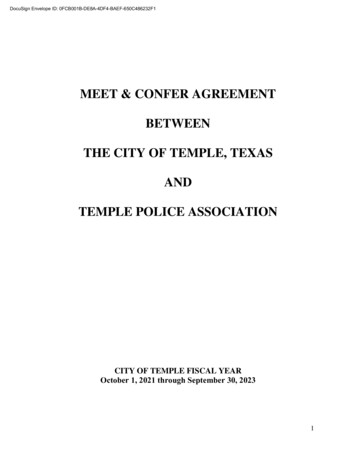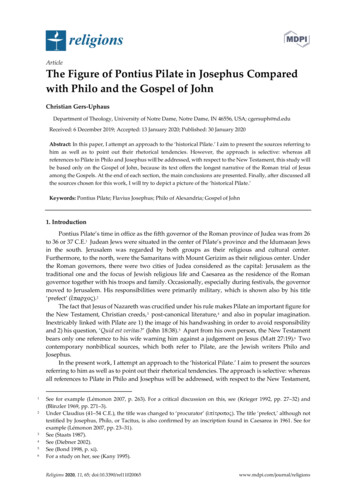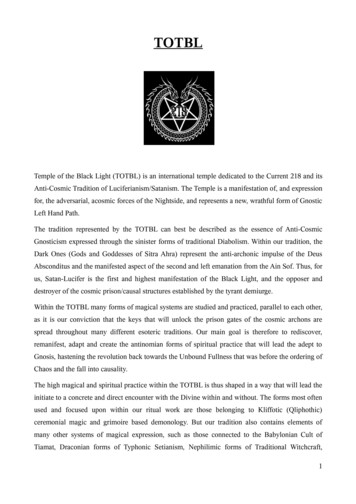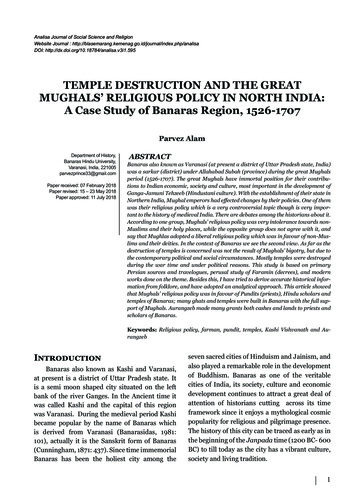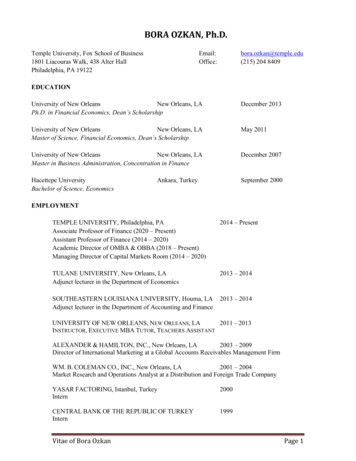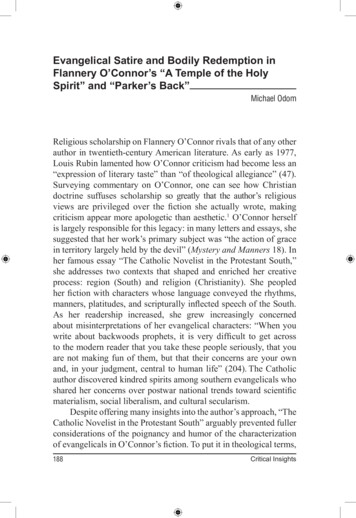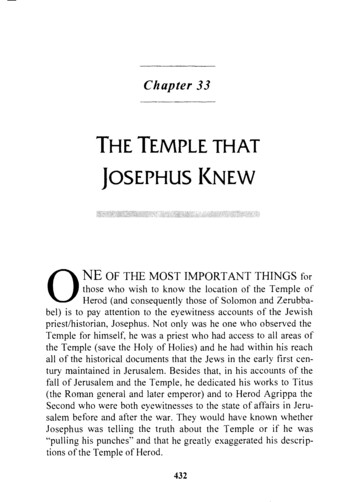
Transcription
Chapter 33THE TEMPLE THATJOSEPHUS l(NEW0NE OF THE MOST IMPORTANT THINGSforthose who wish to know the location of the Temple ofHerod (and consequently those of Solomon and Zerubbabel) is to pay attention to the eyewitness accounts of the Jewishpriest/historian, Josephus. Not only was he one who observed theTemple for himself, he was a priest who had access to all areas ofthe Temple (save the Holy of Holies) and he had within his reachall of the historical documents that the Jews in the early first century maintained in Jerusalem. Besides that, in his accounts of thefall of Jerusalem and the Temple, he dedicated his works to Titus(the Roman general and later emperor) and to Herod Agrippa theSecond who were both eyewitnesses to the state of affairs in Jerusalem before and after the war. They would have known whetherJosephus was telling the truth about the Temple or if he was"pulling his punches" and that he greatly exaggerated his descriptions of the Temple of Herod.432
The Temples that Jerusalem Forgot433It ought to be apparent to any reasonable person that the narratives of Josephus (especially when they are consistent with oneanother, and they are in regard to the Temple) should be given agreat deal of credence in letting us know the facts of what pre-warJerusalem and the Temple were like. If one would simply let Josephus state the evidence that he gives (and believe him), the truesite of the Temple of Herod would have been recognized long ago.The truth is, Josephus describes a Temple that was very differentthan what modern scholars assume to be the fact. In no way doesJosephus have in mind the remains of the Haram esh-Sharif whenhe spoke about the Temple of Herod that once existed in Jerusalem. Josephus had an altogether different building complex inmind when he spoke of the Temple.Before we look at the clear and illuminating description of theTemple of Herod (and his historical analysis of the building of thestructure from the time of Solomon), we should be aware of onegeographical feature associated with the Temple that all Jewishpeople would have taken for granted (and so did Josephus) that thepriest/historian did not believe it was necessary to mention asbeing a necessary part of the Temple complex. Two foreigners,however (one from Egypt about 300 years before Josephus, andone Roman who lived in the time of Josephus), felt it was essentialto mention a cardinal feature of the Temple around which thewhole structure was able to maintain its holiness and represent thevery House of God on earth. That was the mention of a naturalspring of water that was found within the precincts of the Templeto provide the needed water supplies (both ritualistically and forordinary cleaning purposes) that any ''House of God" would haveto have in order to function as a suitable residence of God on earthor in heaven. Let us notice what these two foreigners had to sayabout the Temple and its furniture and the necessary facility thatmade the building a holy and divine Sanctuary that could adequately represent the "House of God" on earth.The first witness is that of Aristeas who came from Egypt toJerusalem about 300 years before the time of Josephus. He leavesus a report of what he saw with his own eyes. Notice that he makesa point of the fact that inside the Temple area "the water supply is
434The Temples that Jerusalem Forgotinexhaustible since there is an abundant natural spring that gushesout from inside the Temple area." 636 Tacitus, the Roman, said thesame."The Temple resembled a fortress and had its own walls, whichwere more laboriously constructed than the others. Even the colonnades with which it was surrounded formed an admirable outerdefense. It contained an inexhaustible spring." 637Readers, the only spring in the Jerusalem area (and there is noother for at least five miles in any direction) is that known in theHoly Scriptures as the Gihon Spring. That natural spring that gavean inexhaustible supply of spring water was, according to Aristeasand Tacitus, WITHIN THE VERY PRECINCTS OF THE TEMPLE! And this is the truth! The fact that this well-known singularspring was IN the Temple shows its Gihon location. It was anindispensable requirement that for a fully equipped building thatwould resemble on earth God's divine House in heaven, that building had to contain a natural spring where purified water could beobtained for certain essential rituals that demanded such things.True, we know that in the time of the Hasmoneans (the Maccabees) and also in that of Pilate, there were two aqueducts thatbrought water from south of Bethlehem to the Temple and the FortAntonia area to supplement the ordinary water sources found inJerusalem. But these two aqueducts were built because of an expanding population and they were built after the time of Aristeas.The original supply of water for the Temple was from the "inexhaustible spring" that was found within the walls of the Temple atJerusalem. This was the Gihon Spring (the only spring in Jerusalem). This was the original (and only) spring that was located within the Temple walls. Now note this. The Gihon Spring is situatedjust over 1000 feet south of the Dome of the Rock and it is evenabout 600 feet south of the southern wall of the Haram esh-Sharif.When, in a moment, we review Josephus' description of the Temple and its outer walls, we must understand that we will be readingabout a building that had the Gihon Spring in its confines and was636637Letter of Aristeas, emphases mine.Tacitus, History, V, 11-12.
The Temples that Jerusalem Forgot435almost a quarter of a mile south of the Dome of the Rock. The twoareas will be utterly different from one another.Josephus' Description of the TempleThe first thing that Josephus does is to show what the mountainwas like on top of which Solomon built the Temple in his time.Remember that this was formerly the area of the threshing floor ofOman who sold the area to King David so that he could constructthe Sanctuary of God on its summit. Though Josephus is describing events that happened a thousand years before his time, he wasstill giving information about the precise spot where the Temple ofHerod had been built. There was no doubt to Josephus, or theJewish authorities at his time, that Herod's Temple was still constructed in the same general area as that of Solomon's (thoughenlarged very much from Solomon's Temple). So, what Josephusis stating is a description of the former hill on which Solomonbegan to build his Temple. What Josephus states is very instructive, and in no way can it be said that he is describing any areaaround the present Dome of the Rock or anywhere in the region ofthe Haram esh-Sharif. Note what Josephus stated.'The Temple was seated on a strong hill, the level area on its summit originally barely sufficed for shrine [the Holy of Holies and theHoly Place] and the altar [the Altar of Burnt Offering], the groundaround it being precipitous and steep." 638Notice carefully that the Temple was first constructed on a"strong hill." It was a steep hill that was pretty easy to defendbecause of its precipitous features. Note that the area on top wassurrounded by cliffs that went downslope in a manner that was"precipitous and steep." The area on top of this strong hill was notlarge. It was so constrained in its top area that "its summit barelyUust barely] sufficed for shrine and the altar." How much spacewas this on top of this strong and precipitous hill that had steepsides all around? Since the Holy of Holies, Holy Place and Altar ofBurnt Offering that Solomon built (as Josephus stated) was about130 cubits (195 feet) in length: The Holy of Holies was 60 cubits638War V.5,l.
436The Temples that Jerusalem Forgotlong (90 feet); the porch in front of the shrine (the Holy Place) was20 cubits long (30 feet); and the altar was located southwest of theHoly Place some 30 cubits away (that is, 10 cubits between theporch and the laver, the laver was l 0 cubits wide, and then another10 cubits to the western side of the Altar of Burnt Offering), andthen the Altar of Burnt Offering itself was a square of 20 cubits (30feet), makes a space of about 130 cubits in length (195 feet) fromwest to east. Since we find that Solomon also built his palace andjudgment hall just to the south of the Temple, and on this particularhill that Josephus called a "strong hill," the width of the summitarea must also have measured about 130 cubits from north tosouth. This made an exact square as a platform.How high was this strong hill on which Solomon built the original Temple, his palace and government buildings? Josephus saidSolomon built an east wall (or embankment) that reached upwardsfrom the very base of the hill (that is, from the bottom of theKedron Valley) for 300 cubits (450 feet). This eastern embankment(or wall) ascended upward from the base (from the very floor ofthe Kedron Valley) until it reached an altitude at the level area ontop of the mountain. This eastern precinct (between the top of thehill and this artificial embankment that Solomon built in the eastand directly over the Kedron Valley) was then filled in with earth,stones and bigger rocks until this eastern embankment reached thetop of the hill some 450 feet above the floor of the Kedron Valley.Josephus tells us that Solomon filled in (in the Bible the Hebrewstates he made the "Millo" - a "filled in" area) with earth andstones. Thus, the steep and precipitous area between the top of thehill and the embankment that Solomon erected out of the floor ofthe Kedron Valley was completely "filled in." Let us see how Josephus describes this very activity of Solomon."But king Solomon, the actual founder of the Temple, havingwalled up the eastern side, a single portico [colonnade] was rearedon this made ground [on top of this artificial 'fill in']; on its othersides [north, west, south] the sanctuary remained exposed [no wallswere built by Solomon on these three sides]. In course of ages,however, through the constant additions of the people to theembankment, the hilltop by this process of leveling up widened
The Temples that Jerusalem Forgot437[they 'filled in' more areas]. They further broke down the northwall [a later activity that was done by Herod] and thus took in anarea as large as the whole Temple enclosure subsequently occupied. Then, after having enclosed the hill from its base [from thefloor of the Kedron and Tyropoeon valleys] with a wall on threesides [after Solomon's time the Israelites built the north, west andsouth walls], and accomplished a task greater than they could everhave hoped to achieve - a task upon which long ages were spentby them as well as all their sacred treasures, though replenished bythe tributes offered to God from every quarter of the world - theybuilt around the block the upper courts and the lower Templeenclosure [the final Temple of Herod was shaped like a squareblock]. The latter, where its foundations were lowest, they built upfrom 300 cubits [450 feet high]; at some spots this figure wasexceeded." 639Though Josephus said that the four walls supporting the Templein his time was shaped as a square block of stones reaching up onthe east side to 450 feet (and in some places even higher) from thefloor of the Kedron Valley, he showed that most of the eastern partof the Temple was built over the earth and rock "fill in" that Solomon and later Israelites placed within the eastern embankment(and finally within the embankments caused by the building of theother three walls on the north, west and south). This square blockof supportive walls with an abundance of "fill in" materialappeared (as we will soon see) as a 40 to 45 story tower that aroseout of the floor of the Kedron Valley and with its southern andnorthern sides extended westward over the ridge between theKedron and Tyropoeon Valleys. Indeed, the western wall [or side]of the Temple [this square blocked tower] also arose out of theTyropoeon Valley (though the western side was not as high). Buteven besides the external visible parts of the four walls surrounding the Temple tower, there were also a great number of foundation stones that supported the Sanctuary structure that could not beseen because they were built below ground. Josephus continues:"The whole depth of the foundations was, however, not apparent[not all of the foundation stones of the Temple could be seen]; forthey [Israelites over the ages] filled up a considerable part of the639Ibid.
438The Temples that Jerusalem Forgotravines [the Kedron and the Tyropoeon Valleys] wishing to levelthe narrow alleys of the town. Blocks of stone were used in thebuilding measuring 40 cubits (60 feet long]; for lavish funds andpopular enthusiasm led to incredible enterprises, and a task seemingly interminable was through perseverance and in time actuallyachieved." 640This does not end the description of the Temple by Josephus.He goes into much more elaborate detail that highlights the actualappearance of the Temple and its walls. The whole complex hadthe appearance of a square blocked tower that was 400 hundredcubits square at the summit of its construction (a Greek stadium inlength on each side, or 600 feet by 600 feet). At the summit (whichwas 300 cubits high or 450 feet) Herod built a level platform onwhich he constructed four colonnades with roadways on top tosurround the square block. In the interior of this platform (indeed,Josephus said "in its center") Herod built the Sanctuary itself withits outer courts on the east and its inner courts (those of the priestsand the Holy of Holies) on the west. The whole structure rose up toa height of a modern skyscraper some 40 to 45 stories above theextreme depths of the Kedron Valley. This was nowhere near theDome of the Rock.The Prodigious Heights of the Temple WallsLet us look further at the eyewitness accounts of Josephus thattell us about the dimensions of the Temple of Herod and where itswalls were positioned in the first century. We should start with afurther description of the east wall. Josephus said the foundation ofthat wall was built by Solomon and was still in existence in thetime of Herod. Though Josephus seems to say the eastern wall wasa creation of Solomon, he may only mean that its early foundational stones were those of Solomon.641 There were also enlargeIbid.There is the statement in the Septuagint Version of Sirach that Simon, theson of Onias, in the early third century B.C.E., was responsible for making morefoundational stones and "doubling the height" of the Temple walls. This Simon(often identified with the extraordinary powerful High Priest called Simon theRighteous) also made the Temple into a mighty fortress with battlements atintervals along the walls. See LXX, Ecclesiasticus 50: 1-2, also Charles, Apoc640641
The Temples that Jerusalem Forgot439ments to the Temple in the time of Simon the Hasmonean. We alsoknow that Herod in his time extended the eastern wall northwardfrom the original wall that he found in existence at his time.Whatever the case, the southeast corner of this wall was located atthe extreme bottom of the Kedron Valley - right in the very floorof the valley. Josephus did not say it was located over half way upthe west slope of the Kedron Valley as is the southeastern corner ofthe Haram. He said it was situated at the very bottom (or at the"foot") of the Kedron Valley."He [Solomon] also built a wall below, beginning at the bottom ['atthe foot' of the eastern hill, Loeb translation] which was encompassed by a deep valley [the Kedron]." 642It is time to pay attention to these accounts of Josephus. Thisposition for the wall in the valley floor (at the very foot of theslope of the Kedron Valley) required that a type of manmade channel or viaduct be constructed to direct water around the easternwall from rains or melting snow. This allowed water to flow in aconduit that avoided undermining the southeastern angle of Solomon's (and Herod's) Temple.One of the reasons Solomon placed the foundation of his eastern wall at the bottom of the ravine was to give the appearance ofheight and impressiveness to the completed structure. The fact thatSolomon placed the foundation of the east wall in the floor of theKedron Valley is confirmed by Josephus in his account of theRoman general Pompey in his attack against the Temple in 63B.C.E. (this was before Herod and his rebuilding activities)."At this treatment Pompey was very angry, and took Aristobulusinto custody. And when he was come to the city [Jerusalem], helooked about where he might make his attack. He saw the wallswere so firm, that it would be hard to overcome them. The valleybefore the walls was terrible [for depth]; and that the temple, whichwas within that valley, was itself encompassed with a very strongwall, insomuch that if the city were taken, that temple would be asecond place of refuge for the enemy to retire to." 643rygha and Pseudepigraphica, vol.I, p.507.42 Antiquities XV.11,3.643 War I. 7, I.
The Temples that Jerusalem Forgot440There is no ambiguity in this reference. Josephus cites historicalrecords giving eyewitness accounts of what former people sawconcerning the position of the eastern wall of the Temple. Pompeyobserved that the foundation of the eastern wall was located withinthe lowest part of the precipitous ravine. It was at the very bottom.The walls Pompey saw in this reference were not those aroundthe Haram esh-Sharif. It is evident to anyone who presently viewsthe walls of the Haram that its southeastern angle is not down inthe very floor of the Kedron Valley. Indeed, the southeastern corner of the Haram is conspicuously located over half way up thewest side of the Kedron slope. And farther north at the northeasternangle of the Haram, the walls of the Haram are situated at the verytop of the ridge. Pompey, however, saw very different walls thanthose perched near or on top of the slope. The eastern wall of theTemple that Pompey saw (and that he referred to) had its foundations at the floor of the Kedron Valley - in the very bottom of theravine. Even the entire northern wall of the Temple (from itsnortheast corner to its northwest corner) was viewed by Josephusas being of "tremendous depth. " 644But the southeastern angle of the walls surrounding the Templewas even higher in elevation. That southeastern corner of Solomon's and Herod's Temple wall towered high above the very floorof the Kedron Valley. Josephus said that in his time this easternangle of the wall was on the average 300 hundred cubits in height(450 feet, as high as a 40 to 45 story building). What? Could Josephus really mean this? It appears ridiculous in the extreme to somescholars that the walls surrounding the Haram esh-Sharif couldever have been that high. Yes, indeed, this would be the case ifpeople consider the southeast angle of the Haram as the cornerwall of the Temple Josephus was referring as an eyewitness. Thatsoutheast angle of the Haram could never have been that high, norwas it located directly in the very floor of the Kedron Valley. Thetruth is, however, Josephus is not speaking of the eastern wall ofthe Haram or of its southeast angle. The wall to which Josephusreferred was 450 feet in height. Note again what he said:644War I.7,3.
The Temples that Jerusalem Forgot441"The latter [the eastern wall], where its foundations were lowest,they built up from a depth of three hundred cubits; at some spotsthis figure was exceeded." 645Yes, the eastern wall of the Temple was even higher than 450feet in some places! Moreover, Josephus went on to say that thisawesome height of the eastern wall of the Temple was exceeded atthe southeastern angle. He indicated the southeastern comer of thewall, up to the highest point of the Temple (perhaps this means tothe top of the "pinnacle" [wing] of the Temple where the NewTestament states Satan took Jesus), had a height of no less than400 cubits (it reached upward 600 feet above the very bottom ofthe Kedron Valley floor). Josephus said:"He [Solomon] made that Temple which was beyond this a wonderful one indeed, and such as exceeds all description in words; nay, ifI may so say, is hardly believed upon sight; for when he had filledup great valleys with earth, which, on account of their immensedepth, could not be looked on when you bent down to see themwithout pain, and had elevated the ground four hundred cubits [600feet], he made it to be on a level with the top of the mountain onwhich the Temple was built." 646Josephus went on to say: "This wall was itself the most prodigiouswork that was ever heard of by man." 647This wall of the Temple at its southeast angle was 600 feet highfrom the lowest of the foundation stones to the top of the colonnades located at the southeast corner (or perhaps the 600 feetincluded the height of the "pinnacle" which could mean theextended height of the "Royal Cloister" that was located on thesouthern wall and reached to the eastern wall).Whatever the case, even the eastern wall of the Temple at itsnortheast angle was also extremely high, and we are told by Josephus that this corner was located directly over the Kedron Valley(not up on the ridge and away from the slope of the Kedron as isthat of the Haram esh-Sharif).645646647War V.5,1, Loeb translation.Antiquities VIII.3,9.Antiquities XV.11,3.
The Temples that Jerusalem Forgot442"The Romans also burnt the whole northern portico [colonnade]right up to that on the east, where the angle [northeastern angle ofthe Temple wall] connecting the two was built over the ravinecalled the Kedron, the depth at that point being consequentlyterrific." 648This description by Josephus is very different from that associated with the northeast corner of the present Haram esh-Sharif. Thepresent northeast angle of the Haram is located on top of the ridge.Indeed, it is on a flat part of the ridge. It is actually about 100 feetwest of the slope that goes down into the Kedron. The simple truthis, these two northeast corners belong to two different walls thatsurround two different facilities. When Josephus spoke of the eastern wall of the Temple with its southeast and northeast angles, hewas not in any manner referring to those angles in the walls nowsurrounding the Haram esh-Sharif.And as far as the southeastern corner of the Temple wall is concerned, modern scholars can hardly believe that one must measure600 feet downward from the "pinnacle" to reach the lowest of thefoundation stones of the Temple wall in the floor of the KedronValley. As a comparison in height, this eastern wall would havebeen 120 feet higher than the top of the great pyramid of Cheops inEgypt (the largest and highest of the pyramids). And remember,Josephus was reporting these measurements concerning the wallsof the Temple as an eyewitness. He was writing his book to KingAgrippa and others in the royal family (plus to Titus the Romanemperor) who were also eyewitnesses to these immense and awesome dimensions of the Temple walls.Josephus, as a historian/priest, had been to the Temple manytimes and he observed the enormous height of the southeast angledirectly over the Kedron, and the northeast angle also of greatheight (though not quite as high) located directly over the KedronValley as well. Notice the superlatives in language Josephus usedin describing this wonderful and majestic scene of this precipitouseastern wall that supported the "pinnacle" of the Temple at itssoutheast angle.648War Vl.3,2 Loeb ed.
The Temples that Jerusalem Forgot443"This cloister [that is, the southeast corner of the southern colonnade] deserves to be mentioned better than any other under the sun.For while the valley was very deep, and its bottom could not beseen, if you looked from above into the depth, this farther vastlyhigh elevation of the colonnade stood upon that height, insomuchthat if anyone looked down from the top of the battlements, ordown both these altitudes, he would be giddy, while his sight couldnot reach to such a great depth." 649So high was the southern colonnade at the southeast corner ofthe Temple wall that Josephus said the Temple (when looked atfrom the south of Jerusalem) could be seen for "a great manyfurlongs. "650Josephus was describing the final architectural aspects ofHerod's Temple, but he acknowledged many of these features wereassociated with the original Temple of Solomon. 651 Of course,Solomon's Temple was nowhere as large as Herod's Templefinally became. Indeed, the Jewish authorities after the time ofAlexander the Great enlarged the size of Solomon's original designAntiquities XV .11,5.Antiquities XV.11,3.651 While Josephus said in War V.5,1 that the top of the eastern wall ofHerod's Temple was 300 cubits' above the Kedron Valley (or higher in places),he said in Antiquities VIII.3,9 the height was 400 cubits (that is 100 cubitshigher). Reading the texts carefully means that the extra 100 cubits (of the 400cubits' measurement) remained below ground because "the whole depth of thefoundations was not evident; for they filled up a considerable part of theravines" (War V.5,l). And inAntiquities VlII.3,9, Josephus said Solomon "filledup great valleys with earth." This means Solomon actually filled in with earththe original Kedron Valley (to the height of 100 cubits) and then on top of thisfoundational "fill-in," his east wall ascended another 300 cubits exposed to theair up to the top of the Temple wall. However, we are told that it was Simon, theson of Onias, in the early third century B.C.E. who actually doubled the heightof the walls around the Temple (see Ecclesiasticus 50: 1-2). Josephus may beincluding this further heightening of the Temple walls by Simon in his description. Whatever the historical truth, Josephus was certainly giving proper dimensions for the eastern wall of Herod's Temple of which he was an eyewitness.Did Josephus include the height of the "pinnacle" in his 400 cubits height at thesoutheast angle? The word "pinnacle" actually means "wing" (or side building)and it may have been a scenic view area and not a "tower." There is no ritualistic or symbolic reason shown in the Bible why a "tower" had to be at that corner. If there were a "tower" at that spot (as we have illustrated as a possibility),it was only for aesthetic and/or observational purposes.649650
444The Temples that Jerusalem Forgotby doubling the height of the walls,652 and that Herod himselfmade the Temple larger still.We have an eyewitness account from the man named Hecateuswho visited Jerusalem near the time of Alexander the Great. Hesaid that Solomon's platform for the Temple was only 150 feetwide. 653 You will remember that in the time of Herod, the Templeplatform on which the Temple stood was a square of 600 feet oneach side. Herod doubled the size of the Temple that was in hisday. Josephus said he "enlarged the surrounding area to double itsformer extent [that is, double the size of the Temple which was inexistence in his time]." 654 Josephus said such extensions weremade over the ages since the time of Solomon. But even thesmaller lateral dimensions of Solomon's earlier Temple were grandand awe-inspiring. Josephus said:"He [Solomon] made that Temple which was beyond this a wonderful one indeed, and such as exceeds all description in words; nay, ifI may so say, is hardly believed upon sight; for when he had filledup great valleys with earth, which, on account of their immensedepth, could not be looked on when you bent down to see themwithout pain, and had elevated the ground four hundred cubits, hemade it to be on a level with the top of the mountain on which theTemple was built." 655In giving these large dimensions of height for the Temple walls(which he considered so outstanding and full of grandeur), Josephus readily admitted that most people who had never seen theTemple would have expressed disbelief at these enormous measurements. But Josephus was dedicating this very work to KingAgrippa and to the Emperor Titus who were both eyewitnesses aswell to the enormity of the height of the Temple walls. There is noreason to doubt Josephus' evaluation when he said the eastern wallEcclesiasticus 50: 1."The Jews have only one fortified city; they call it Jerusalem. Nearly in thecenter of the city stands a stone wall [of the Temple], enclosing an area about500 feet long and 150 feet broad, approached by a pair of gates" (Josephus,Contra Apion I.22).654 War l.2 I , I.655 Antiquities Vlll.3,9.652653
The Temples that Jerusalem Forgot445of the Temple "exceeds all descriptions in words." He also said:"the wall was itself the most prodigious work that was ever heardof by man.''656 In stating these facts, Josephus admitted that the"immense depths" of the dimensions of the eastern wall could be"hardly believed."To Josephus the whole vista was wonderful beyond compare.And without doubt, this precipitous eastern wall of the Temple wastruly a glorious work of art. The Temple platform was at the top ofthese steep walls. The Temple (on its square platform) was viewedas perched on top of a perfectly squared TOWER that reachedupward 40 to 45 stories like a modem skyscraper occupying asquare block of area in New York or Chicago. This square-shapedTOWER was located 600 feet south of the southern wall of FortAntonia and it was connected to the fort by two arched bridgespositioned side-by-side that attached the northwestern comer of thesquare Temple platform with the southwestern comer of Antonia.It was a magnificent sight to behold.What Is Modern Opinion of these Statements?The majority of historians today stand back in utter disbelief inwhat these eyewitness accounts of Josephus attest. Most modernscholars cannot believe that there is any veracity in Josephus' narratives of these wonderful dimensions of the Temple described inhis early accounts. They simply brush aside the information andsuggest that Josephus was simply up to his old tricks of exaggeration. They think the poor guy must have
Temple for himself, he was a priest who had access to all areas of the Temple (save the Holy of Holies) and he had within his reach all of the historical documents that the Jews in the early first cen tury maintained in Jerusalem. Besides that, in his accounts of the fall of Jerusalem and the Temple, he dedicated his works to Titus


